Working with large numbers of smaller influencers is a logistical challenge, and requires the right set of tools
How would you like to recruit an army of influential people -- each with hundreds or even thousands of loyal followers -- to promote your brand?
If this sounds good to you, then you understand the rising popularity of micro-influencer marketing. Micro-influencers can sway opinions, there are millions of them, and many are already eager to work with brands. In fact, you likely already have micro-influencers among your brand’s customer and fan base.
Ready? Not so fast. In order to get results with micro-influencer marketing, you need to scale your campaign across hundreds, even thousands of influencers (depending on your needs). These are real people, not ad units, and there’s no simple way to automate the process of getting these individual influencers to promote you, let alone handle logistics like negotiation, content creation, and payments. You’ll need to understand the complex ecosystem of influencer marketing tools, services, and techniques to achieve ROI in your micro-influencer campaign.
Micro-influencers are loosely defined as bloggers or social media influencers with 100,000 followers or fewer. Studies have found that these smaller influencers have greater engagement, loyalty, and sway with their audiences than the big-name celebrity influencers. However, to achieve scale in your marketing campaign, you need to work with a large number of these folks, which presents some logistical challenges, such as:
- Finding the right influencers
- Contacting them (and getting responses)
- Negotiating terms
- Manage the content development process
- Paying influencers
- Following up
- Tracking success
Scaling an influencer marketing campaign requires solid planning, great communication, and a smart combination of the right tools.
First, determine your needs
This may seem obvious, but I’m surprised how often I’ve seen marketers dive into influencer marketing without fully outlining their needs.
What are your marketing goals?
One common trap that marketers fall into is to jump into an influencer campaign without fully thinking through their marketing objectives. For example, some marketers assume that once they convince a few popular Instagrammers to post images of their product, the sales will start rolling in. Quite the contrary. Instagram promotion can work for some categories such as fashion or travel, but can fall flat for other categories.
As a first step, determine what outcome you’d like to achieve from your influencer campaign. What do you want?
- Build awareness?
- Drive sales?
- Gather leads?
- Email signups?
- Increase your social media followers?
- Get reviews?
- Unboxing videos?
- SEO links?
- Stunning imagery?
What platforms and formats are you targeting?
Based on your goals, you can then determine which platforms and formats you’d like to target for your campaign. Keep in mind that the end goal of any influencer marketing campaign is the creation of some form of content. It can be a YouTube video, an Instagram post, a pin on Pinterest, a Tweet, or a blog post.
Who is your target influencer?
Once you have an idea of the content you’d like to create, and which platforms are a best fit for your brand, then you can begin to define the right influencer for your campaign.
- How many followers?
- What do they talk about?
- On which platform(s) do they drive engagement?
- Audience characteristics. Age, gender, location of their followers should match your target customers.
Now that you’ve outlined your goals and your target influencer, the hard part begins of actually finding these influencers and convincing them to promote your brand. Broadly speaking, you have three major options for doing this, 1) tap into an influencer marketplace, 2) build your own database (DIY approach), and 3) partner with a full service influencer marketing service. There are pros and cons to each, and a wide range of influencer marketing tools to help, and based on my 3+ years of running influencer marketing campaigns, I’ve laid out some of the best options for you here.
Connect with influencers by tapping into an influencer marketplace
When it comes to contacting influencers, you can either contact them directly or via a marketplace. Direct contact requires you to build a list of influencers and reach out to them directly, usually via email. Marketplaces offer you an existing directory of pre-qualified influencers which you can browse or search, or some will even match you up with influencers based on best fit criteria.
The upsides of using a marketplace are speed and efficiency. You can skip the time-consuming steps of building a list of influencers, finding their contact information, and communicating with each one separately. Plus each marketplace will typically have certain parameters for their influencers, such as YouTubers, or influencers within particular categories, which can speed your search process.
Famebit is the most popular marketplace for reaching YouTube influencers. Famebit has over 70,000 influencers in its marketplace, and has the added cachet of actually being owned by YouTube (Google acquired it in 2016).
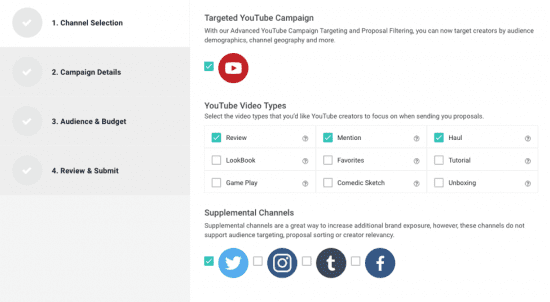
On Famebit, you simply list your campaign, select the types of influencers you want to work with, and then you can either invite influencers or influencers will apply to promote your product. Famebit charges 20% of the fee paid to the influencer.
Octoly is another popular YouTube marketplace. Similar to Famebit, you can list your product and campaign in Octoly’s marketplace and either receive applications or invite YouTubers to promote you.
Octoly’s unique aspect is that brands cannot provide monetary compensation to influencers, their system works around free product samples only. This may work for smaller YouTubers, but larger influencers will typically require a fee so may not be listed on Octoly.
Influenster is a very popular shopping community site which caters to small influencers who like to review products. They have 3 million influencers on their platform who post product reviews on the Influenster website.
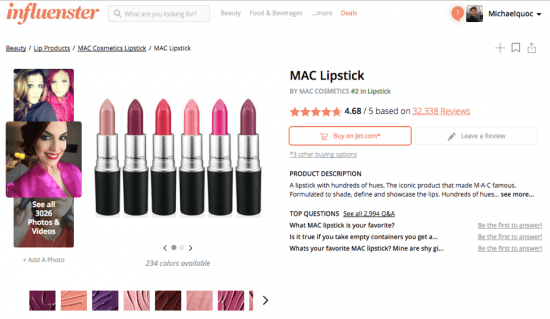
As a brand, you can submit your product to be included in one of their “VoxBoxes” which are boxes of free product samples they ship out to their influencers.
This is an easy way to get your product in front of small influencers and regular shoppers who will review your product and mention it on social media. Influenster has a strong community of beauty influencers, as well as lots of influencers who talk about food and cooking, home and health products.
Build your own database of influencers
The downside of listing in a marketplace is that you may be limited in the customizability of your campaigns. Marketplaces set their own parameters around what types of influencers they list and the types of campaigns that can be run. Either you’ll be limited to influencers on a specific platform such as YouTube or Instagram, or you’ll be limited to certain review formats.
If you need greater customizability in your campaigns, you’ll need to create your own database of influencers and handle outreach on your own. Luckily, there are a wide range of tools to assist you with this too.
How to find influencers
One of the most common ways to discover influencers through the content that they create. Depending on your target media or platform, just search for content that’s similar to the content you’d like to create (reviews, unboxings, imagery)
If you’re targeting YouTube reviews, then a great place to start is to search YouTube for reviews of products similar to yours, and build your list based on who is creating great content. Likewise for Twitter, Facebook, Pinterest, or Google for bloggers. You can start by searching on each platform for content you like.
You can also use one of the many influencer search tools available. These tools are designed to help you search through content and lists of influencers to speed up the process of locating influencers.
Buzzsumo is probably the most popular tool for searching for influencers. You can search for content.
Buzzsumo will show you content relating to your keyword that has the greatest visibility in terms of social shares or linking sites. You can target either the author of the content or the people who shared it on Twitter.
You can also search directly for influencers by keyword:
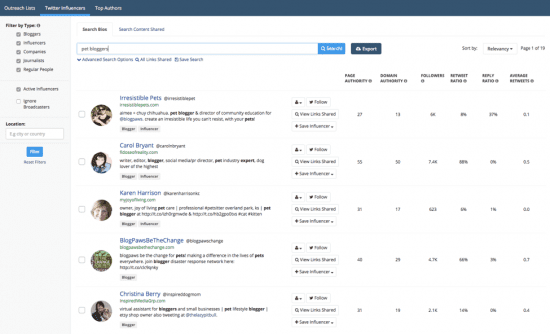
Buzzsumo will show you key statistics like blog authority and Twitter followers. You can add influencers to lists to follow up with later.
Another useful tool is Ahrefs. While this is primarily an SEO-focused service, Ahrefs has a very nice content discovery tool called Content Explorer which is similar to Buzzsumo’s content search feature.
Ahrefs includes some powerful filtering options - you can filter by publication date to find only recent posts, or even by word count, say if you’re looking for in-depth content only.
Buzzstream (which we’ll discuss again below) is one of the most popular CRM tools for managing communications with influencers. However, they recently launched an influencer discovery service called Buzzstream Discovery which is another great way to find influencers.
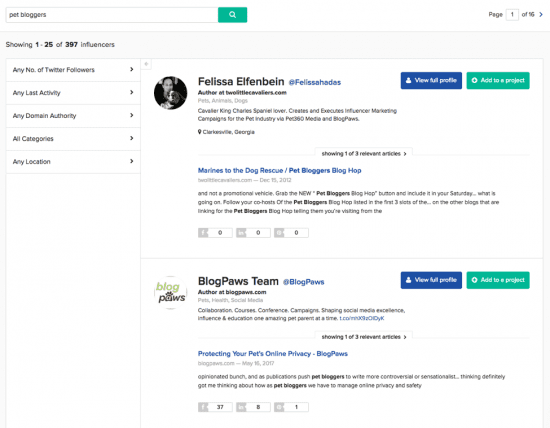
Discovery works similar to the influencer search feature of Buzzsumo, where you search directly for influencers by keyword. Buzzstream Discovery has great coverage of influencers and provides very useful stats on each influencer’s level of engagement and activity.
How to contact influencers at scale
Once you’ve developed your list of influencers to target, you’ll need to get in contact with them. Typically the best way to do this is via email. If they have a blog, you can usually find the contact information there. Otherwise, you can try messaging them on the various social platforms, but typically you’ll have the best luck with email.
However, if your list is large, say hundreds or even thousands of influencers, you’ll need some tools to automate this process.
Buzzstream is best known for its excellent Outreach service. Buzzstream Outreach is a full CRM system designed primarily for blogger outreach, but over time it has evolved to be a capable influencer outreach system.
On Buzzstream you can create Projects which act like folders to contain all your contacts for a given campaign. These contacts can include bloggers or social media influencers.
You can either add influencers through Buzzstream’s Discovery service (mentioned above) or you can upload your own list. Once you add contacts, Buzzstream will automatically crawl the web for contact information for anyone you add to your project.
Once a contact is loaded to your Buzzstream project, you can access their profile and email them directly from Buzzstream.
You can also email them from another email client, and as long as you connect your email server to Buzzstream, all communications will be tracked in one place. This is a great way to collaborate across team members in case multiple people are contacting influencers in your project.
Gmail and Google Sheets with Extensions
Of course, sometimes the old fashioned way is the best way. Gmail plus Google Sheets is a simple but very effective way to manage a large outreach campaign.
There are some great browser extensions you can install for Google Chrome or Mozilla Firefox which can aid in finding contact information for large numbers of websites.
Hunter
Hunter is a very popular extension which will automatically find contact email addresses for any site you visit.
Buzzstream buzzmaker
Buzzstream makes an extension called the Buzzmarker which will not only find contact email addresses but will streamline your entire process by automatically navigating you to all the sites in a given project, while it picks up contact information for each one, which you then manually approve as you go.
Gmass
If you need to send emails out to a large group of people, Gmass is a powerful extension for Gmail that makes this easier. The way Gmass works is simple. After installing the extension, you just setup your email distribution list in Google Sheets, then setup your email template in Gmail, using variables to populate with various data items such as First Name and Website Name. Then send the email using Gmass in Gmail, and your mass email will be sent out with a click.
Gmass will track open rates and click rates for you, so you can easily A/B test different email templates.
Full service influencer platforms
Yet another way to scale an influencer marketing campaign is to use a full-service influencer marketing platform. These combine some of the advantages of the flexibility of building your own database with the speed and efficiency of working with a marketplace. Unlike structured marketplaces like Famebit or Octoly, full service platforms enable you to create your own style of campaign whether it involves smaller or larger influencers, YouTube videos or blog posts, Pinterest pins or Tweets, these platforms let you define your campaign needs. They also act as marketplaces, connecting you with influencers in their network, often helping you connect with the right ones based on your campaign needs.
Tomoson is a popular full service influencer marketing platform. On Tomoson, you can define your campaign needs, and through the platform you can connect with influencers to promote your campaign.
Tomoson’s network includes micro-influencers on Twitter, Instagram, YouTube, Facebook, and bloggers, and they support sponsored content features, unboxing videos, and social mentions.
Tomoson’s platform helps you manage all your communications with influencers and aids with processes such as tracking packages for product samples.
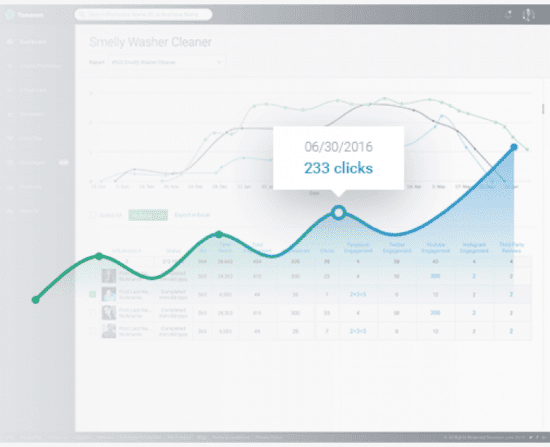
Tomoson also tracks campaign analytics for you, so you can see clicks, engagement, and even conversions for your campaigns.
BrandBacker is another full service influencer marketing platform which helps you connect with influencers. Brandbacker connects you with their network of influencers and offer agency-type services to help you craft your campaign and find the right influencers to promote it. Brandbacker also provides mention-tracking services, so you can monitor mentions of your brand and content created about your brand across social channels.
The big picture
The challenge of running a micro-influencer marketing campaign is that you’ll need to coordinate with a large number of influencers. Finding, contacting, negotiating with, monitoring, and reviewing content created for a campaign can be a logistical nightmare.
Influencer marketplaces are a great place to start if you’re looking for a relatively simple promotion such as YouTube reviews or Instagram posts.
If your needs are more complex, or you know you’re looking for a specific type of influencer, you’ll need to build your own database of influencers and contact them yourself. To scale a self-managed influencer outreach project, you’ll want to use outreach tools such as Buzzsumo, Buzzstream, and Ahrefs to speed up the discovery and contact processes. You can also utilize some simple extensions for Chrome and Gmail to make this process more efficient.
Finally, if you’re comfortable making a commitment to a single vendor, full service influencer marketing platforms can help you with the heavy lifting of contacting and coordinating with influencers, while providing you with useful campaign performance analytics as well.
Thanks to Michael Quoc for sharing his advice and opinion in this post. Michael is the founder and CEO of
Dealspotr. You can follow him on
Twitter or connect on
LinkedIn.











